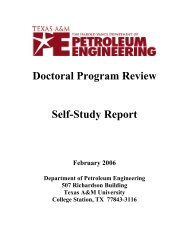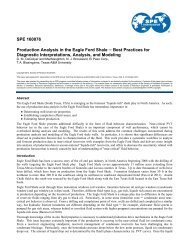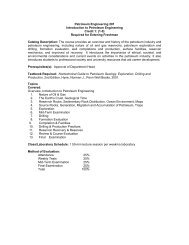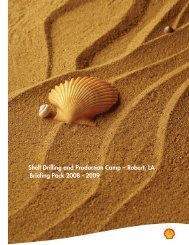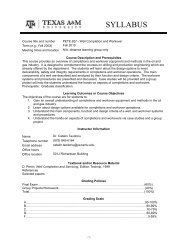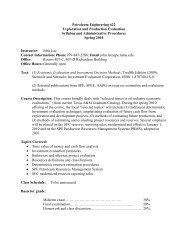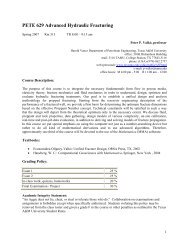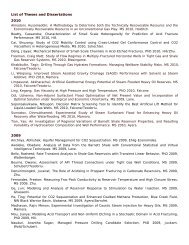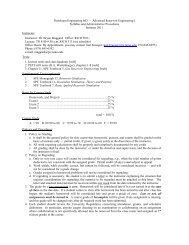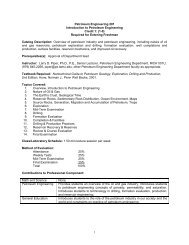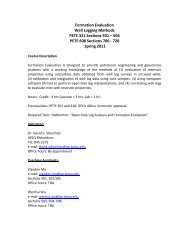Crisman Annual Report 2009 - Harold Vance Department of ...
Crisman Annual Report 2009 - Harold Vance Department of ...
Crisman Annual Report 2009 - Harold Vance Department of ...
You also want an ePaper? Increase the reach of your titles
YUMPU automatically turns print PDFs into web optimized ePapers that Google loves.
Numerical Modeling <strong>of</strong> Fracture Permeability Change in Naturally Fractured<br />
Reservoirs using a Fully Coupled Displacement Discontinuity Method<br />
Introduction<br />
Pressure depletion in a naturally fractured reservoir<br />
can result in effective stress change that, in turn,<br />
can affect fracture aperture and the reservoir<br />
permeability. The dependence <strong>of</strong> fracture aperture and<br />
reservoir permeability on stress must be considered<br />
in modeling a naturally fractured reservoir. The<br />
dependence involves coupled interactions among<br />
fluid, porous matrix, and fracture. The previous<br />
methods on the dependence <strong>of</strong> fracture permeability<br />
on the pressure depletion did not consider the fully<br />
coupled interactions <strong>of</strong> fluid, porous matrix, and<br />
fracture or the real deformation mechanism <strong>of</strong><br />
fracture.<br />
Approach<br />
We developed a new approach to solve the fluid<br />
pressure, stress change, and fracture aperture<br />
change in fractures simultaneously. We did this<br />
by combining a finite difference method (FDM) to<br />
solve the fluid diffusion in fractures a fully coupled<br />
displacement discontinuity method (DDM) to<br />
build the global relation <strong>of</strong> fracture deformation,<br />
and a nonlinear Barton-Bandis model <strong>of</strong> fracture<br />
deformation to build the local relation <strong>of</strong> fracture<br />
deformation. The fully coupled DDM is based on<br />
Biot’s theory <strong>of</strong> poroelasticity which is a linear<br />
elastic theory to account for the coupled interactions<br />
between porous matrix and fluid in a porous medium<br />
saturated with a compressible fluid. The analytical<br />
solution <strong>of</strong> induced stress and pore pressure by the<br />
deformation <strong>of</strong> a finite thin fracture in an infinite<br />
elastic porous medium is provided. The influences<br />
<strong>of</strong> deformation <strong>of</strong> complicated fracture network are<br />
obtained by the superposition <strong>of</strong> the fundamental<br />
analytical solution. The stress acting on the fracture<br />
surface and the deformation <strong>of</strong> the fracture also must<br />
comply with the fracture deformation model (e.g.<br />
Barton-Bandis model). The fluid flow in the fracture<br />
network is solved by an FDM. The interface flow<br />
rate between the fracture and matrix is implicitly<br />
included in the fully coupled DDM. As a result, the<br />
approach is able to model the fracture deformation<br />
due to reservior pressure change in naturally<br />
fractured reservoirs by considering the fully coupled<br />
interactions <strong>of</strong> fluid, porous matrix, and fractures.<br />
Application<br />
This method has been applied to model the fracture<br />
permeability change for a two-dimensional regular<br />
Fig. 1. Pore pressure (psi) distribution after 360 days production.<br />
fractured network (Fig. 1) in a compressible<br />
single-phase fluid-saturated porous medium. Under<br />
isotropic in-situ stress conditions, the fracture<br />
permeability decreases with the pressure reduction<br />
during production (Fig. 2). But at high anisotropic<br />
stress conditions, the fracture permeability could<br />
be enhanced by production due to shear dilation<br />
(Fig. 3).<br />
(continued on next page)<br />
Project Information<br />
3.2.10 Well Test Models for Caves in a Karstic Carbonate<br />
Reservoir<br />
Contacts<br />
Christine Ehlig-Economides<br />
979.458.0797<br />
c.economides@pe.tamu.edu<br />
Qingfeng Tao<br />
CRISMAN INSTITUTE<br />
<strong>Crisman</strong> <strong>Annual</strong> <strong>Report</strong> <strong>2009</strong><br />
75



